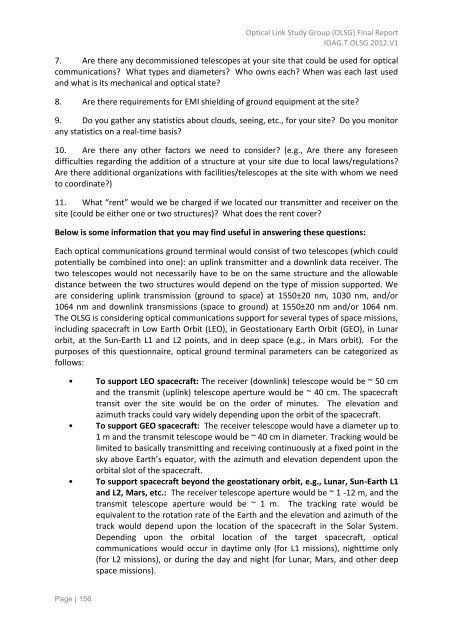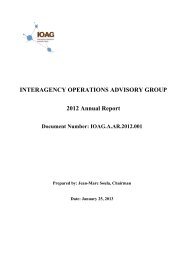OLSG Report_Final_06_05_12 - Interagency Operations Advisory ...
OLSG Report_Final_06_05_12 - Interagency Operations Advisory ...
OLSG Report_Final_06_05_12 - Interagency Operations Advisory ...
Create successful ePaper yourself
Turn your PDF publications into a flip-book with our unique Google optimized e-Paper software.
Optical Link Study Group (<strong>OLSG</strong>) <strong>Final</strong> <strong>Report</strong><br />
IOAG.T.<strong>OLSG</strong>.20<strong>12</strong>.V1<br />
7. Are there any decommissioned telescopes at your site that could be used for optical<br />
communications? What types and diameters? Who owns each? When was each last used<br />
and what is its mechanical and optical state?<br />
8. Are there requirements for EMI shielding of ground equipment at the site?<br />
9. Do you gather any statistics about clouds, seeing, etc., for your site? Do you monitor<br />
any statistics on a real-time basis?<br />
10. Are there any other factors we need to consider? (e.g., Are there any foreseen<br />
difficulties regarding the addition of a structure at your site due to local laws/regulations?<br />
Are there additional organizations with facilities/telescopes at the site with whom we need<br />
to coordinate?)<br />
11. What “rent” would we be charged if we located our transmitter and receiver on the<br />
site (could be either one or two structures)? What does the rent cover?<br />
Below is some information that you may find useful in answering these questions:<br />
Each optical communications ground terminal would consist of two telescopes (which could<br />
potentially be combined into one): an uplink transmitter and a downlink data receiver. The<br />
two telescopes would not necessarily have to be on the same structure and the allowable<br />
distance between the two structures would depend on the type of mission supported. We<br />
are considering uplink transmission (ground to space) at 1550±20 nm, 1030 nm, and/or<br />
1<strong>06</strong>4 nm and downlink transmissions (space to ground) at 1550±20 nm and/or 1<strong>06</strong>4 nm.<br />
The <strong>OLSG</strong> is considering optical communications support for several types of space missions,<br />
including spacecraft in Low Earth Orbit (LEO), in Geostationary Earth Orbit (GEO), in Lunar<br />
orbit, at the Sun-Earth L1 and L2 points, and in deep space (e.g., in Mars orbit). For the<br />
purposes of this questionnaire, optical ground terminal parameters can be categorized as<br />
follows:<br />
• To support LEO spacecraft: The receiver (downlink) telescope would be ~ 50 cm<br />
and the transmit (uplink) telescope aperture would be ~ 40 cm. The spacecraft<br />
transit over the site would be on the order of minutes. The elevation and<br />
azimuth tracks could vary widely depending upon the orbit of the spacecraft.<br />
• To support GEO spacecraft: The receiver telescope would have a diameter up to<br />
1 m and the transmit telescope would be ~ 40 cm in diameter. Tracking would be<br />
limited to basically transmitting and receiving continuously at a fixed point in the<br />
sky above Earth’s equator, with the azimuth and elevation dependent upon the<br />
orbital slot of the spacecraft.<br />
• To support spacecraft beyond the geostationary orbit, e.g., Lunar, Sun-Earth L1<br />
and L2, Mars, etc.: The receiver telescope aperture would be ~ 1 -<strong>12</strong> m, and the<br />
transmit telescope aperture would be ~ 1 m. The tracking rate would be<br />
equivalent to the rotation rate of the Earth and the elevation and azimuth of the<br />
track would depend upon the location of the spacecraft in the Solar System.<br />
Depending upon the orbital location of the target spacecraft, optical<br />
communications would occur in daytime only (for L1 missions), nighttime only<br />
(for L2 missions), or during the day and night (for Lunar, Mars, and other deep<br />
space missions).<br />
Page | 156



